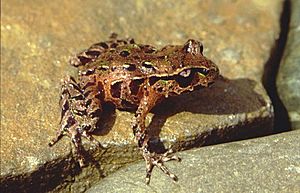Archey's frog facts for kids
Quick facts for kids Archey's frog |
|
|---|---|
 |
|
| Conservation status | |
| Scientific classification | |
| Genus: |
Leiopelma
|
| Species: |
archeyi
|
 |
|
| Distribution of Archey's frog | |
The Archey's frog, also known as Leiopelma archeyi, is a very old type of frog. It lives only on the North Island of New Zealand. This frog is one of only three living species in a special frog family called Leiopelmatidae.
It was named after Sir Gilbert Archey. He used to be the director of the Auckland War Memorial Museum. The first official example of this frog is kept at that museum. You can find Archey's frogs only in the Coromandel Peninsula and near Te Kuiti in New Zealand. These frogs are like "living fossils." They have not changed much in over 200 million years!
Where Archey's Frogs Live
Archey's frogs live on land, not in water. They prefer damp places under plants in native forests. Today, you can only find them high up in two areas. But just 25 years ago, these frogs were common. They lived in many more places, even down by the sea.
We do not know much about their daily lives. Male and female frogs look alike. But male frogs seem to be the main caregivers. They might make special "nests" for the eggs. They also guard the eggs. They put special liquids on the eggs to help them grow.
Reproduction and Life Cycle
A female frog lays between four and 15 eggs. The eggs are laid on land, not in water. The tadpoles grow inside jelly-like egg capsules. When they hatch, tiny froglets crawl onto the male frog's back. These froglets still have tails.
The male frog carries the froglets for several weeks. During this time, they finish changing into adult frogs. Adult Archey's frogs do not make loud calls. They might use chemical signals to talk to each other. But if a predator scares them, they sometimes make a loud noise.
Protecting Archey's Frogs
Archey's frogs are in danger. In one area, a group of frogs dropped by 88% from 1996 to 2001. In many places where frogs used to be common, none are left. Because their numbers are falling fast, these frogs are at high risk of disappearing forever.
Scientists have studied why these frogs are declining. One problem is a disease called chytridiomycosis. However, some frogs in the wild showed other signs of sickness. These included blisters.
A special program was started in 2002. It aimed to breed Archey's frogs in zoos. This was to protect them from diseases. Frogs successfully bred at the University of Canterbury. In 2005, the program moved to Auckland Zoo. Sadly, many frogs died there. But in 2012, some frogs at Auckland Zoo had babies. This was an important step for their survival.
Archey's frogs are listed as "Nationally Vulnerable" in New Zealand. They are also "Critically Endangered" on the IUCN Red List. This means they are very close to extinction.
Other animals can harm Archey's frogs. Rats and an introduced frog species called the green and golden bell frog are known to kill them. Other animals like pigs, cats, hedgehogs, and ferrets also hunt frogs in New Zealand. They likely affect Archey's frogs too.
See also
 In Spanish: Leiopelma archeyi para niños
In Spanish: Leiopelma archeyi para niños


